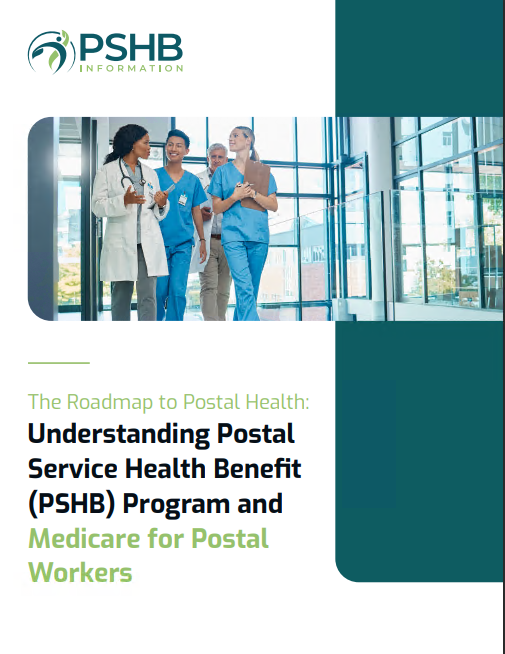Key Takeaways
-
The Postal Service Health Benefits (PSHB) program provides robust healthcare coverage tailored to the unique needs of USPS employees and retirees.
-
With Medicare integration and varied plan options, PSHB ensures comprehensive benefits for individuals and families.
Understanding the PSHB Program: What You Need to Know
The Postal Service Health Benefits (PSHB) program is a cornerstone of healthcare coverage for USPS employees, annuitants, and their families. Transitioning from the Federal Employees Health Benefits (FEHB) program, PSHB is designed specifically to meet the needs of postal workers. If you’re part of the USPS workforce, understanding your PSHB options is vital for making informed decisions about your healthcare.
A Tailored Approach for Postal Workers
PSHB recognizes the distinct challenges and requirements of postal employees. Unlike general federal health plans, PSHB offers specialized coverage that considers the physical demands and unique risks associated with postal work. This program ensures you have access to the care you need without unnecessary complexity.
Comprehensive Coverage for All Phases of Life
Whether you’re actively employed, transitioning into retirement, or supporting a family, PSHB plans are designed to provide comprehensive coverage. These plans address various needs, including:
-
Preventive care and wellness visits
-
Emergency and urgent care
-
Chronic condition management
-
Prescription drug coverage
Enrollment Periods and Eligibility: Stay Informed
Key Timelines to Remember
Enrollment in PSHB aligns with Open Season, typically held in late fall. This period allows you to evaluate your current plan, compare new options, and make necessary changes. For 2025, Open Season ran from November 11 to December 13, with changes effective January 1. Outside of this period, you can modify your plan only during Qualifying Life Events (QLEs).
Who Is Eligible?
Eligibility for PSHB extends to USPS employees, annuitants, and their eligible family members. If you retired on or before January 1, 2025, special rules apply regarding Medicare enrollment. Understanding these nuances ensures you and your family maintain uninterrupted coverage.
Medicare Integration: A Seamless Partnership
Coordinating Benefits with Medicare
For Medicare-eligible annuitants and family members, PSHB integrates with Medicare Part B to enhance coverage. This integration can lower out-of-pocket costs, reduce deductibles, and provide additional benefits. If you’re nearing Medicare eligibility, be sure to enroll in Part B to maximize your PSHB benefits.
What About Prescription Drugs?
PSHB plans include prescription drug coverage through a Medicare Part D Employer Group Waiver Plan (EGWP). This ensures affordable access to medications, particularly for those with chronic conditions requiring regular prescriptions.
Comparing Costs: What You Can Expect
Premium Contributions
While PSHB premiums vary based on your selected plan and family size, the federal government covers approximately 70% of the total cost. This shared contribution helps make high-quality healthcare more accessible.
Deductibles and Out-of-Pocket Limits
Plans offer a range of deductibles, from low-deductible options suited for frequent healthcare users to high-deductible plans ideal for those who prioritize lower premiums. For 2025, in-network deductibles range between $350 and $2,000, while out-of-network deductibles are higher, ranging from $1,000 to $3,000.
Coinsurance and Copayments
Coinsurance rates for in-network services range from 10% to 30%, ensuring affordable access to routine and specialized care. Copayments for essential services include:
-
$20-$40 for primary care visits
-
$30-$60 for specialist visits
-
$50-$75 for urgent care visits
-
$100-$150 for emergency room visits
Enhanced Benefits for Medicare Enrollees
Lower Costs, More Coverage
If you’re enrolled in both PSHB and Medicare Part B, you may qualify for waived or reduced deductibles and lower copayments. Some plans even offer partial reimbursement for Medicare Part B premiums, providing significant savings over time.
Maximizing Your Benefits
By combining PSHB with Medicare, you ensure access to a broad network of providers and enhanced prescription drug benefits. This synergy is particularly valuable for retirees managing long-term health conditions.
Choosing the Right Plan: Tips for Decision-Making
Assess Your Healthcare Needs
Start by evaluating your current and anticipated healthcare needs. Consider factors such as chronic conditions, family size, and the frequency of doctor visits. This assessment will guide you toward plans that align with your priorities.
Compare Plan Options
During Open Season, review the benefits, premiums, and out-of-pocket costs for each available plan. Many resources, including plan brochures and online comparison tools, can help you make an informed choice.
Don’t Forget Dental and Vision Coverage
PSHB plans may include options for dental and vision benefits, ensuring comprehensive care beyond medical needs. Explore these offerings to determine if they’re a good fit for you and your family.
Staying Prepared: What to Do Before Open Season
Review Your Current Plan
Before Open Season begins, take time to assess your current coverage. Identify any gaps or areas where your plan falls short, such as high out-of-pocket costs or limited provider networks.
Gather Necessary Information
Keep your employment and annuity details handy, as they’ll be essential for enrollment. If you’re enrolling in Medicare Part B, ensure you have your Medicare number and other relevant documentation.
Mark Important Dates
Set reminders for Open Season and any other critical deadlines. Missing these dates could leave you without the coverage you need for the upcoming year.
Making the Most of PSHB Benefits
Leverage Preventive Services
Most PSHB plans cover preventive care at no additional cost, including annual checkups, vaccinations, and screenings. Taking advantage of these services can help you maintain good health and catch potential issues early.
Utilize Wellness Programs
Many PSHB plans offer wellness incentives, such as gym memberships, smoking cessation programs, and health coaching. Explore these benefits to support your overall well-being.
Understand Your Provider Network
Choosing in-network providers ensures you receive the highest level of coverage at the lowest cost. Familiarize yourself with your plan’s network to avoid unexpected expenses.
Addressing Common Questions
What Happens if I Don’t Enroll in Medicare Part B?
If you’re required to enroll in Medicare Part B for PSHB coverage and choose not to, your healthcare options may be limited. You’ll also face late enrollment penalties if you decide to enroll later.
Can I Keep My Current Doctor?
Most PSHB plans have extensive provider networks, increasing the likelihood that your current doctor is included. However, it’s always a good idea to verify this during Open Season.
Are Family Members Covered?
Eligible family members, including spouses and dependents, can be covered under your PSHB plan. Review the eligibility criteria to ensure your loved ones are included.
Planning Ahead: The Future of PSHB
Keeping Up with Changes
The healthcare landscape is constantly evolving, and PSHB is no exception. Stay informed about policy updates, premium adjustments, and new plan features to maximize your benefits.
Preparing for Retirement
If you’re nearing retirement, consider how your healthcare needs will change. Enrolling in Medicare and selecting the right PSHB plan can help you transition smoothly into this new phase of life.
Maximizing Your Healthcare Coverage
Taking full advantage of the Postal Service Health Benefits program ensures you and your family receive comprehensive, affordable healthcare. By staying informed and proactive, you can navigate plan options, enrollment periods, and Medicare integration with confidence. As healthcare needs evolve, PSHB is here to support you every step of the way.








